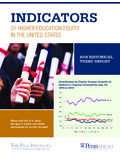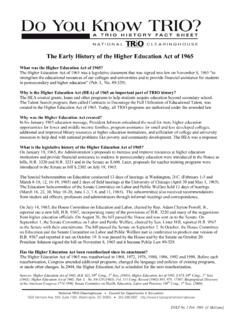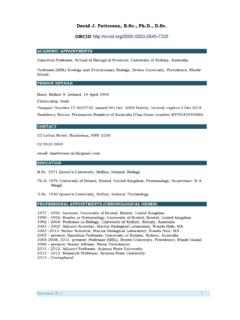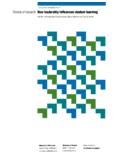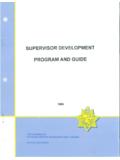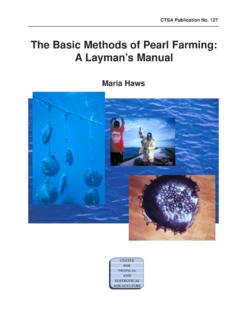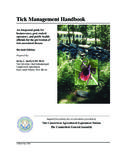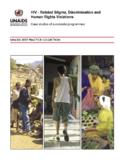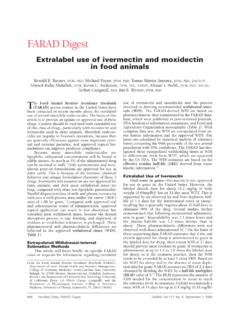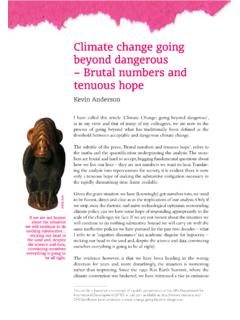Transcription of Moving Beyond Access - Pell Institute
1 M o ving Be y o nd Ac c e s s College Succe s s F o r L o w - I n c o m e , Fi rst-Ge ne ra t ion S t udent s 2 0 08. A BO U T T H E P E L L IN S T ITU TE. T. he Pell Institute for the Study of Opportunity in Higher Education, sponsored by the Council for Opportunity in Education, conducts and disseminates Senior Scholars research and policy analysis to encourage policymakers, educators, and the Adolfo Bermeo public to improve educational opportunities and outcomes for low-income, first- Thomas Mortenson Lana Muraskin generation, and disabled college students. The Pell Institute is the first research Congressman Louis Stokes Institute to specifically examine the issues affecting educational opportunity for this Vincent Tinto growing population. A d v i s o ry C o mmi t t e e F o r fu rth er informat ion contac t: Sonya Anderson, The Oprah Winfrey Foundation Estela Bensimon, University of Southern California Betsy Brand, American Youth Policy Forum Chandra Taylor Smith, , Director Alberto Cabrera, University of Maryland - College Park THE PELL Institute Heather Eggins, Staffordshire University For the Study of Opportunity in Higher Education David Evans, Educational Policy Consultant 1025 Vermont Avenue, NW, Suite 1020 Donald Heller, Pennsylvania State University Washington, DC 20005 Scott Miller, Pennsylvania Higher Education Assistance Agency P: Barmak Nassirian, American Association of Collegiate Registrars and Admissions Officers F.
2 Raymund Paredes, Texas Higher Education Coordinating Board Thomas Wolanin, Institute for Higher Education Policy M o ving Be y o nd Ac c e s s College Succe s s F o r L o w - I n c o m e , Fi rst-Ge ne ra t ion S t udent s Jennifer Engle, Vincent Tinto, TA B L E O F CONT ENTS. Acknowledgements .. 1. Executive Summary .. 2. Introduction Why College Success Matters .. 5. Who Are Low-Income, First-Generation Students? .. 8. How Do Low-Income, First-Generation Students Fare in College? .. 11. What Are the Constraints on College Success for Low-Income, First-Generation Students? .. 20. How Colleges Can Promote Success for Low-Income, First-Generation Students .. 25. Conclusions and Recommendations .. 28. References .. 30. A CK NO WLEDGEMEN TS. T. his report was written by Jennifer Engle, former Senior Research Analyst, and Vincent Tinto, Senior Scholar at the Pell Institute . The report was edited by Colleen O'Brien, former Director of the Pell Institute , and Susan Trebach, former Vice President for Communications at the Council for Opportunity in Educa- tion.
3 Ryan Davis, Abby Miller, Brian Estes, and Tiffany Jones at the Pell Institute also provided research assistance for this report. We would like to thank a number of individuals who provided assistance in the analysis and writing of this report. First, we'd like to thank Lutz Berkner, Senior Research Associate at MPR Associates, for his technical assistance with gaining Access to the data for this research. We'd also like to thank Michelle Cooper, Presi- dent of the Institute for Higher Education Policy, and Kenneth Redd, Director of Research and Policy Analysis at the National Association of College and University Business Officers, for providing valuable feedback on the research design and for reviewing the report draft. Finally, we'd like to acknowledge the 3M Foundation for providing support for this study. We heartily acknowledge the efforts of these individuals in the process of conduct- ing this research. We also recognize that responsibility for the content of this report, including any errors or omissions, lies solely with the authors.
4 Acknowledgements 1. EX ECU T IVE S U MMARY: Moving Beyond Access : College Success for Low-Income, First-Generation Students W h y Do es Co llege Succe ss Matter ? H ow Do L ow- I n c o m e , F i rs t- G e n e r at i o n S t u d e n ts Far e i n C o ll e ge ? W. ith major strides in Access to postsecondary education for all students in recent decades, it is tempting to assume that such progress has erased For most of the million low-income, first-generation students enrolled in post- disparities in college enrollment and completion in the United States. Yet secondary education today (approximately 24 percent of the undergraduate popu- despite having one of the highest college participation rates in the world, large gaps lation), the path to the bachelor's degree will be long, indirect, and uncertain. For persist in terms of Access to and success in higher education in this country, particu- many, the journey will end where it begins.
5 Using data from the National Center for larly for low-income, minority, and first-generation students. Education Statistics' Beginning Postsecondary Study (BPS:96/01), we found that low-income, first-generation students experience less success than their peers right Given the pressure to remain competitive in the global knowledge economy, it is in from the start. Across all institution types: our shared national interest to act now to increase the number of students who not Low-income, first-generation students were nearly four times more likely 26 to 7. only enter college, but more importantly earn their degrees, particularly bachelor's percent - to leave higher education after the first year than students who had neither degrees. Due to the changing demographics of the United States, we must focus our of these risk factors. efforts on improving postsecondary Access and success among those populations who Six years later, nearly half (43 percent) of low-income, first-generation students had have previously been underrepresented in higher education, namely low-income and left college without earning their degrees.
6 Among those who left, nearly two-thirds minority students, many of whom will be the first in their families to go to college. (60 percent) did so after the first year. In order to inform the efforts of educators and policymakers to improve college After six years, only 11 percent of low-income, first-generation students had earned Access and success, the Pell Institute has produced a report, funded by the 3M bachelor's degrees compared to 55 percent of their more advantaged peers. This was Foundation, that examines the current status of low-income, first-generation college due in part to lower graduation rates for low-income, first-generation students in students1 in higher education. Using data from the Department of Educa- the four-year sector: tion datasets, we describe the ways in which this population participates in higher In public four-year institutions, only 34 percent of low-income, first-generation stu- education, including persistence and degree attainment rates, and compare their dents earned bachelor's degrees in six years compared to 66 percent of their peers.
7 Participation to other students, including those who are neither low-income nor In private, not-for-profit four-year institutions, there was an even larger gap between first-generation. We discuss the barriers that low-income, first-generation students low-income, first-generation students and their peers, 43 to 80 percent respectively. face to achieving success in college, as well as the strategies that colleges and universities can pursue to address these barriers and improve students' chances of earning degrees. We also offer recommendations for institutional and government Despite such gaps, low-income, first-generation students were actually more than actions that could go a long way towards closing the Access and success gaps that seven times more likely to earn bachelor's degrees if they started in four-year insti- exist today for this doubly-disadvantaged population. tutions, but only 25 percent of them did so. A large number of low-income, first-gen- eration students began - and ended - their studies at public two-year and for-profit institutions.
8 More advantaged students who began at public two-year institutions went on to attain bachelor's degrees at nearly five times the rate of low-income, first-generation students, 24 versus 5 percent respectively. This is due largely to higher transfer rates among students who were neither low-income nor first-generation; only 14. percent of low-income, first-generation students attending public two-year and for- profit institutions transferred to four-year institutions within six years compared to 1 Low-income status is defined as having a family income below $25,000 and first-generation status includes students whose parents do 50 percent of their more advantaged peers. not have bachelor's degrees. Here we focus our comparisons between low-income, first-generation students and students who are neither low-income nor first-generation. 2 Moving Beyond Access It is worth noting that not all students who attend public two-year and for-profit Due largely to a lack of resources, low-income, first-generation students are more institutions enroll with the intention of earning bachelor's degrees.
9 Many of these likely to live and work off-campus and to take classes part-time while working full- students plan to and successfully complete certificates and associate's degrees. How- time, which limits the amount of time they spend on campus. As our research using ever, we found that 63 percent of low-income, first-generation students attending data from NCES' National Postsecondary Student Aid Study (NPSAS:04 UG) shows, public two-year institutions said they planned to earn at least a bachelor's degree, unmet financial need need that remains after applying all financial aid is a ma- with nearly half of these students aspiring to post-baccalaureate degrees. Yet, only 5 jor problem for low-income, first-generation students. The mean amount of unmet percent of them actually earned bachelor's degrees within six years. need for low-income, first-generation students is nearly $6,000 (before loans), which represents half of their median annual income of $12,100.
10 As a result, they work Thus, we see that while public two-year and for-profit institutions are major and borrow more with negative consequences in terms of college completion. points of initial Access to postsecondary education for low-income, first-generation students, and provide a reasonable opportunity to earn certificates or associate's H ow Ca n W e P r o m o t e C o ll e g e A c c ess a n d S u c c ess degrees, the chances of successfully attaining the increasingly important baccalau- f o r L o w-I nc o m e , F i r s t- G e n e r at i o n S t u d e n t s ? reate degree via these institutions are limited for this population. For too many low-income, first-generation students, the newly-opened door to Amer- W h at Are th e Constraints on Co ll e ge S uc c e ss ican higher education has been a revolving one. The unavoidable fact is that while f o r Low- In come, First-Gene rat ion S t ude nt s ? college Access has increased for this population, the opportunity to successfully earn a college degree, especially the bachelor's degree, has not.




